IR has engaged Wainhouse for thought leadership and insight on the enterprise benefits from monitoring, analytics, diagnostics, and optimization of workplace communications and collaboration — also known as performance and experience management. This ebook provides the reader with an overview and analysis of IR’s performance management platform and its associated value proposition — managing services for Cisco, Microsoft, Zoom, and Avaya enterprise voice, video, meeting services, and contact center.
IR Collaborate is a complete end-to-end solution for performance and experience management, powered by IR’s Prognosis platform. Collaborate provides four major capabilities for both unified communications and contact center – 1) monitoring, troubleshooting, analytics, and optimizing for Unified Communications, Collaboration, and Contact Center environments (UC Assessor); 2) a network readiness assessment and testing solution; 3) customer experience validation testing with outside-in load and performance validation (StressTest); and 4) availability and performance (HeartBeat).
Download a PDF of the Wainhouse Research Report on Managing Complexity in Complex Times

Download a PDF of the Wainhouse Research Report on Managing Complexity in Complex Times
Why Read This?
In today’s work from home (WFH) environment, ensuring 100% uptime of team collaboration is more critical than ever.
However, that is not always possible.
Networks, clients, devices, and people cause outages, errors, and ultimately suboptimal experiences.
Fortunately, most network providers, unified communication and collaboration platform vendors, and an increasing number of device manufacturers provide their own management and monitoring tools.
However, this creates its own challenge. Most organizations have multiple telecom providers, calling solutions, meeting solutions, and an array of group video conferencing systems from different vendors — connected by network devices from multiple vendors, deployed within the datacenter and across multiple clouds — and each with their own administration tool.
The typical automobile has 30,000 parts from over 200 suppliers. Imagine having to log in to a different administration system for each function in your automobile — one for a/c, one for heat, another for radio, and another, ignition. Instead, auto manufacturers unify control from these different vendors to create a more efficient, productive, and enjoyable driving experience.
Similarly, with workplace communications, IT teams increasingly use more valuable third-party performance management and analytic solutions to efficiently and effectively monitor, troubleshoot, and optimize the user experience. In fact, WH survey data indicates that IT leaders have swung from single vendor to “best of breed” solutions as driving their communications technology decisions.
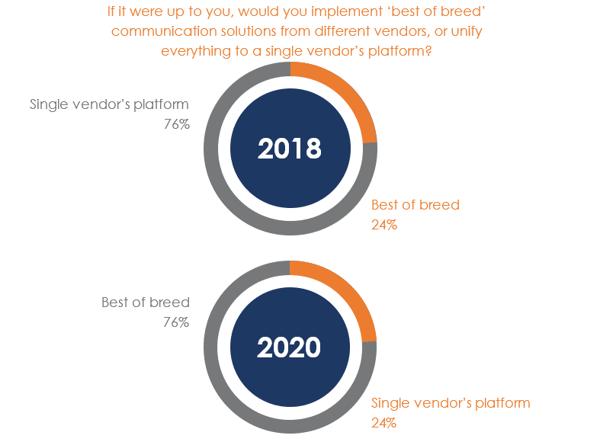
The objective of this paper is to provide the reader with information critical to making an informed decision about monitoring, troubleshooting, and optimizing workplace communications that reside on-premises, in the cloud, or a hybrid combination of the two.
This ebook provides an overview of the need for, and capabilities and benefits of, a third-party performance management system. It combines our industry research with experience working with the enterprise and vendor community.
Unless indicated otherwise, all market data cited is sourced from the Wainhouse (WH) research database or from IR.
While IR commissioned this study, the details provided in this report are unbiased and represent Wainhouse’s perspectives on the topic. The reader should evaluate this insight, and all other technologies and solutions, against their own unique environment and enterprise requirements.
Complexity Defines Today’s Environment
Complexity defines today’s IT environment. There is a vast array of systems and corresponding vendor relationships that make service control and optimization challenging — a complex challenge highlighted across applications, deployments, and devices.
- APPLICATION COMPLEXITY due to a growing array of apps and services supporting workplace communications — most mid-to-large enterprises support calling, messaging, and meeting solutions provided by two or more distinct vendors within each workload.
Q1 2020 Survey of IT Decision Makers — Two or More Vendors by % of responses and average vendor count by workload: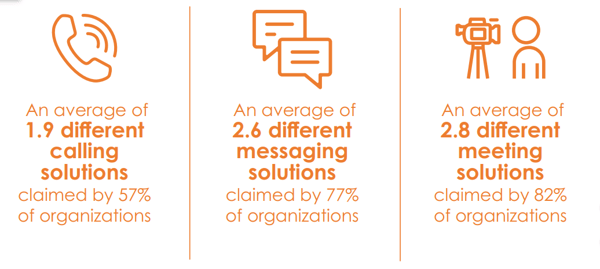
- DEPLOYMENT COMPLEXITY due to cloud migration timeframes, and a growing number of easy-to-access online solutions — hybrid communication and collaboration deployments across the enterprise’s datacenter and provider’s cloud service add complexity across vendor management, administration, and support workflows, and can ultimately create a disjointed user experience. Although counter intuitive, WH survey data shows hybrid environments growing, and pure-cloud deployments actually shrinking over the last five years:
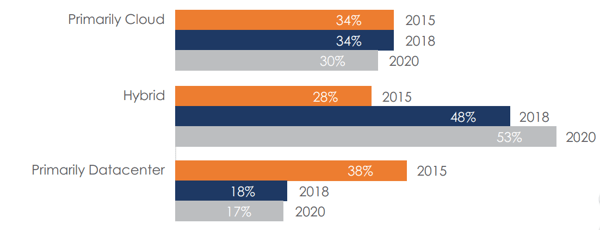
- DEVICE COMPLEXITY due to a shift that has created more multi-device users than app-only users. Consider the trend in users who communicate regularly on a desk phone, PC-based app, and their mobile device:
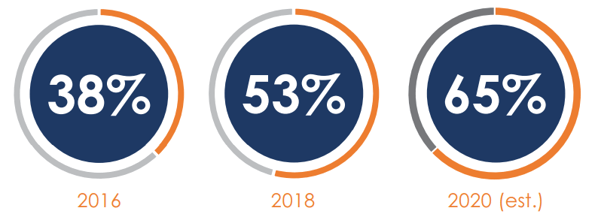
Compound this already complex environment with the dynamic the pandemic has introduced, and it’s clear that IT’s function has been pushed to the edge of its resources to control and optimize the user experience. Consider the CRITICAL function workplace communications have taken on since the pandemic — and the corresponding need to ensure security, connectivity, quality, and consistency of experience.
Sure, workplace communications were important before the pandemic. However, WFH and the emerging “hoteling” office environment make service uptime and consistency more vital to business continuity than they were previously.
People will return to the office, but the purpose of office spaces will change — an outcome of the pandemic will be a drastic change in how employees utilize offices. It will be less about employees going into a building to “work” at a designated desk but will evolve into going into an office to meet, collaborate, and reconnect with fellow employees and the business itself. These interactions were already a part of a typical worker’s day, but going forward we expect these “Dynamic Interactions” will be central to the experience.
As a result, WH expects less office space to be committed to permanent personal use like a cube or a desk, and more of it converted to accommodate day-long visits to the office — for example, personal spaces that you “hotel” at for the day, and can be sanitized each evening. We also expect to see group spaces that align with new healthcare protocols but still promote dynamic interactions. There are already indications that these patterns may drive the need for more group spaces. A room that used to seat eight is now set up for four people to safely maintain social distance. As a result, there is a good chance that the organization may add another four-person room to accommodate the four that could not fit into the first room.
Going forward WH anticipates:
- Working in the office will be different and likely require more video devices in more rooms.
- Workplace hoteling will mean different devices (e.g. PCs, mobile devices) and apps (e.g. cloud calling, personal meetings, team collaboration) are moving to different networks from day-to-day.
- Working from home will become more dynamic — not more consistent — as users move between the office, home, and occasional travel (don’t count on business travel returning to normal for years).
- Engaging current customers and acquiring new prospects will rely on collaboration solutions unlike before — the ability to engage effectively and efficiently will be key when in-person meetings are not possible.
- And people will all be in the middle of this — using, breaking, and demanding that their apps and devices are optimized, fixed,
and always working.
These “seismic shifts” have permanent implications for the global workforce — but despite the disruption, the expectation has not changed: the workforce needs to remain productive, IT needs to support the “new normal,” and the business needs to continue delivering goods, services, and products to clients and customers. This is the definition of COMPLEXITY (as if our jobs were not already tough enough).
The Prescription for Complexity
So, what is the prescription for eliminating complexity in the most vital function within your organization? While the goal of a truly unified communications environment may be ever-elusive, a unified management experience does not need to be.
There is no shortage of tools, standards, and frameworks that can help address the complexity challenge. In the world of IT service management, many share a common base foundation with the Information Technology Infrastructure Library, or ITIL framework — a set of best practices designed to align IT service delivery with business objectives and requirements. Many IT standards leverage the ITIL framework as a basis for their process and procedures, and for good reason: it provides a common language and follows a familiar lifecycle for designing, deploying, and operating complex services. We’ll use the base framework to identify a simplified list of key best practices to help reduce the complexity within your environment: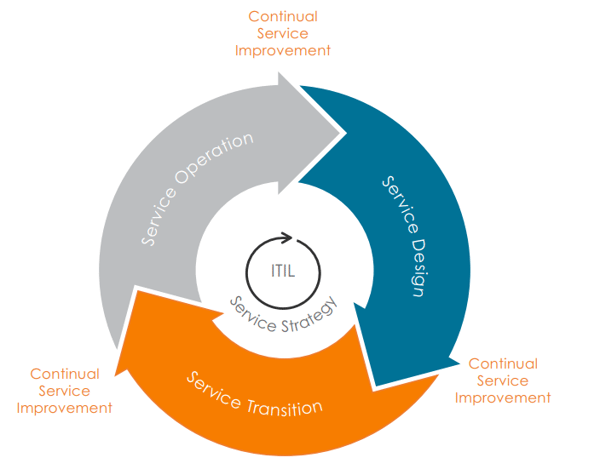
STEP 1 - DESIGN
Reestablish Objectives: Pandemic-induced disruption has required tight coordination between IT and line-of-business leaders. This is a key first step to evaluating short-, mid-, and long-term communication strategies — start with a cross-functional team and establish, or reestablish, the primary business objectives as they relate to communications.
Catalog IT Services: Account for the core systems IT manages and uses to deliver secure communications — directory, monitoring, ticketing, and management solutions. Identify key integration to ERP and other workflow automation systems.
Catalog Business Solutions: Account for all workplace communications apps and devices — what are they, where are they, and who uses them? Include both “sanctioned” and “unsanctioned” solutions.
Assess: Determine how each app, device, and related networks are working. Document your “blind spots” — the apps and solutions outside of IT’s control.
Align: Create a risk profile for apps in IT’s blind spot — do they carry sensitive data? Support customer engagements? Meet regulatory and compliance requirements? Align risky apps with a plan to consolidate to sanctioned and supported solutions and identify the monitoring and management platform that will cover your new de-risked environment end-to-end.
With your new Alignment Plan in place, it’s time to deploy, consolidate, and simplify your environment.
STEP 2 - TRANSITION
Communicate: Engaging the business in the “what” and the “why” — maintain a regular communications tempo moving forward.
Implement: Update existing or deploy a net-new performance management solution that will provide IT with the vision, access, and automation they need to maintain the target experience — from service to network to endpoints, across all environments.
Consolidate: Validate that all sanctioned apps are visible and migrate those unsanctioned apps into your new single pane of glass — a single portal — so that each workload and network connection can be monitored, managed, and optimized.
STEP 3 - OPERATE AND IMPROVE
Monitor: Compare the current experience to the previous environment — focus on common KPIs like ticket volume, mean time to resolution, and quality metrics.
Adapt: Implement logical workflows enabled by the performance management platform — focus on proactive issue notification and automated solutions where possible.
Optimize: Establish new KPIs relevant to the new environment — adoption, engagement, cost management, quality of experience, and user satisfaction. Establish a continuous improvement cycle to find and address the weak links. Evaluate IT team structures that may be optimized as well — look for synergy between traditionally siloed network, security, and application teams.
Anticipate: Update contingency plans and related technology to ensure services are always secure and available to the right users — whenever and wherever they are working. Replace rigidity with flexibility — ask “How would I add, change, or remove users quickly if needed? How would I monitor the process and validate that these changes were successful?”
The Benefits of Proactively Managing Workplace Communications
Quality User Experience — users will trust in a calling, conference, and contact center service that is consistently excellent. Organizations that proactively manage their experience find:
- Up to 60% increase in user satisfaction
- This is typically due to a decrease in service outages and up to 50% faster incident resolution
- Which leads to greater to a 31%¹ gain employee productivity — because calls are reliably clear, and meetings consistently start on time and run well
IT Process Improvement — while IT’s primary goal should be service uptime, which leads to user satisfaction, IT also benefits through:
- Faster service delivery, which lowers implementation costs as much as 27%¹
- Faster issue detection and resolution, and less time troubleshooting in the trenches — often 43%¹ less time
Operational Maturity defines the steps (aren’t we tired of the term “journey”?) organizations go through on their way to aligning user needs with service performance. Have you been part of this process before?
In summary, UC performance management provides:
- Automated alerts (from the system vs. the users) which enable
- Improved visibility into all your networks, apps, and devices, that allows
- Streamlined operations in resolving incidents and
- Improved performance through service quality benchmarks being met, and therefore IT gains
- User satisfaction enabling IT to deliver on its Digital Workplace promise — to both internal users and external customers.
Sounds like nirvana (not the band!) — right? Well, it can be.
Historically, 66% of all IT incidents are reported by users versus automatically reported in real-time by a performance management service. And calls that get escalated usually involve a lot of people — an average of eight.
¹2018-19 Nemertes Research Communications and Collaboration Study
How Does IR Align with Your Needs to Ensure Connectivity, Quality, and Consistency of Experience?
IR’s key solution areas for delivering performance management for Cisco, Microsoft, Avaya, and Zoom UC platforms are:
- Readiness Assessment — ensures network quality and connectivity and allows problems to be fixed prior to service provisioning
- Core UC Performance & User Experience Management — proactive (automated), real-time management, monitoring, troubleshooting, and optimization across multiple UC, Meeting, and Contact Center platforms deployed on-premises, in the cloud, or a mix thereof
- Network Troubleshooting & Insights — root cause isolation of voice and video quality issues with networks
- SBC & SIP Monitoring & Troubleshooting — insight into configuration, operation, and performance with session border controllers (SBC)
- Analytics & Reporting — deep analytics and reporting that provide trend spotting, critical troubleshooting, and solution management information
- Experience Validation Testing — outside-in performance and load testing
This suite of solutions enables complete end-to-end visibility across multiple vendor technologies, apps, and networks. This allows end-to-end analysis and drill-down of call and meeting quality — allowing IT to rapidly ID and resolve incidents before they become widespread productivity-impacting events. Critically, IR’s Collaborate solution delivers the comprehensive ability to manage performance that extends across both cloud and on-premises solutions, giving visibility into complex hybrid environments.
Admittedly, we hear broad-stroke value propositions from UC vendors all the time. So, we put IR’s stated value proposition and approach through our analysis engine. Here’s what we found:
- Vendor Coverage: IR performance management supports an expanding list of compatible solutions, with Avaya, Cisco, Microsoft Skype for Business and Teams, and Zoom platforms supported today
Analysis: The average enterprise supports 2+ calling solutions from different vendors. These four vendors — Avaya, Cisco, Microsoft, and Zoom — currently account for over 60% of the Enterprise Calling and Meetings market combined. Further, their market share only increases when you take the small-business segment out of the mix — we estimate these four vendors account for over 75% of the mid-to-large enterprise market.
So, odds are good that a) you have two different calling vendors to account for, and b) it’s two or more of these vendors (if not all four) supporting your business communications. - Network Readiness Assessment: provides network performance simulation testing and problem identification during the pre-implementation phase or for troubleshooting hard-to-solve problems — delivering up to 27%¹ cost savings during rollout
Analysis: A little more difficult to test, but we don’t doubt this claim. We expect two levels of cost savings here:
- Hard Costs: “Just Throw Bandwidth at It” is a common practice when deploying a new, network-hungry UC solution. Running a formal traffic simulation prior to roll-out is an excellent way to avoid this potentially expensive trap — build and augment what’s needed, based on objective data, vs. based on assumptions and guesswork.
- Time Costs: full network assessments can be time- and resource-consuming — and many related tools are general or generic, missing specific UC components. Overall, it’s hard to argue against the benefits of a UC-specific assessment engine in practice — and benefits should extend from implementation into the production environment.
- UC Performance and Experience Management: proactive alerting, real-time analysis, and historical troubleshooting data
Analysis: We expect fewer trouble tickets and faster resolution timeframes based on this value bullet. The value here might be filed under “intuitively obvious” to both IT and business leaders. Consider, however, the “ripple impact” that comes with business communication outages. Most start out as isolated, with a single user noticing the issue — often it takes two or more bad calls before the user decides to escalate to IT. At that point, IT needs to triage — looking for problems in the network, application, endpoint, and device. The process to just find, much less fix, the problem is time consuming — taking days to weeks, in many cases.
In a best-case scenario, the issue is isolated to a single user — however, these issues often “ripple” across the user community. Depending on the problem, the issue may actually be impacting a team, a site, or an entire service. So, yes — proactive issue detection is a welcome addition. Ideally, IT is aware of specific problems and can solve them before that first user is impacted. - Network Monitoring, Troubleshooting, and Insights provides a UC-specific view and single pane of glass that includes network performance and network element insight
Analysis: Finally. Those of us who have managed a network team are all too familiar with the phrase “it’s probably the network.” That “probably” is what bugs us the most — because it means time and work to prove that the outage is not the network’s fault.
Combining application and network monitoring and troubleshooting is a massive improvement to the app-vs.-network challenge. Of course, sometimes it is an issue with the network — and IR’s approach drives issue detection down to a level that enables the right team to find, address, and solve the real problem’s root cause — without hunting and pecking through each element. Expected result: IT efficiencies, faster resolution, and improved user experience. - Experience Testing and Analytics: proactive outside-in traffic simulation with real calls for insights, analysis, and troubleshooting from the customer’s POV
Analysis: Another silver bullet, from our perspective. The ideal performance management platform not only provides insight into all communication elements — it finds problems on its own. Running regular traffic simulations, identifying problems, and implementing solutions while users are “off the clock” is an ideal situation.
IR also supports “outside-in” testing, validating the user experience from outside of IT’s controlled network. While everything may look rosy to internal users, it’s the external call failures that matter most — undetected PSTN outages, ACD and/or IVR failures, clogged gateways, and overworked session border controllers all can wreak havoc on the customer experience. In this case, what you don’t know CAN hurt you.
Further Considerations & Next Steps
Complex problems should not require complex solutions. As you evaluate your own environment, here are a few suggestions on what to look for:
- Simplify IT: fewer panes of glass, applied where they matter — understand what Best of Breed means to you, and apply it to your critical workflows: provisioning, security, management, and monitoring.
- Simplify the User Experience: understand the workloads that drive your organization — are you messaging, calling, meeting, or client-experience oriented? All four is also an acceptable answer — understanding the business’s priorities and aligning simple but full-featured solutions is the key. Complexity is a productivity killer, plain and simple.
- Find Flexibility: platform strategies have historically reduced some element of choice — limited features, poor user experience, difficult management, or all three. However, today’s leading cloud solutions are built with integration in mind, supporting integration between your core IT and business apps — find the platforms that support what you need today, versus the roadmap promise of tomorrow (filed under pending).
- Future-Proof: easy to say, harder to validate. No one wants to put time and money into a solution, only to find it discontinued and unsupported before you’re done deploying. Understand your vendors’ financial health as a metric for future viability — fly-by-night may deliver an interesting feature set, but that does you no good if they disappear in the morning. Equally important: look at your vendors’ development history — do their release notes show a rapid/agile development process, or a slow and plodding drip of features and integrations? Do they have a proven track record of adding the right integrations to the
platforms that matter most to your enterprise?
Download a PDF of the Wainhouse Research Report on Managing Complexity in Complex Times

Download a PDF of the Wainhouse Research Report on Managing Complexity in Complex Times
About Wainhouse
Wainhouse provides in-depth research and analysis that helps you gain a clear perspective on the market, technology, and services for workplace communications and collaboration. Wainhouse analysts are industry experts in enterprise voice, video, team collaboration, and streaming applications, services, and devices. Our expertise is backed by one of the most comprehensive data sets and models in the world. Our domain expertise and market data combine to deliver in-depth forecasts, enterprise insight, and objective product evaluations that frame the industry’s current state and anticipated direction. Services include syndicated market insight, custom research, and sales enablement.
Content and additional detail is available at https://insight.wainhouse.com and www.wainhouse.com/intro
About the Research Team
 William A. Haskins, Senior Analyst and Partner.
William A. Haskins, Senior Analyst and Partner.
Located in Denver, CO, Bill spearheads Wainhouse’s strategic focus on unified communications products and services. Bill has over 15 years of experience supporting, delivering, and designing converged collaboration services in a global communications environment. He has authored multiple white papers and articles detailing the keys to a successful UCC implementation and delivered various UCC presentations, highlighting his experience integrating collaboration solutions into business process and enterprise applications. Prior to joining WH, Bill served as Director, Unified Collaboration at Global Crossing (later Level3), leading a team of product line managers and application developers responsible for service development, marketing, P&L, customer experience, and product road mapping. Bill holds a B.S. in Marketing from the University of Colorado, and an MBA from Colorado State University.
 Marc Beattie, Senior Analyst and Partner.
Marc Beattie, Senior Analyst and Partner.
Located in Boston, MA, Marc’s area of expertise is cloud-based workplace communication and collaboration. He has authored public and private reports on product strategies, distribution structures, emerging technologies, and industry applications. He is a trusted advisor with end users, established vendors, emerging companies, and the financial community. Prior to joining Wainhouse, Marc was an early member of PictureTel and Polycom — holding positions as market analyst, product management, sales management, and business development — spending 13 years working within the industry.




